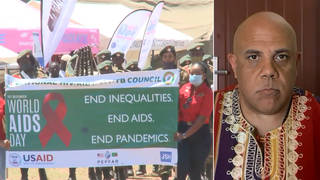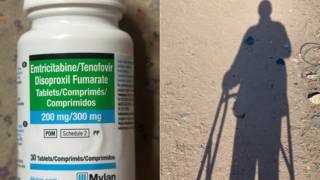
Guests
- Dr. Elly Katabirainternational co-chair of the 2012 International AIDS Conference being held in Washington, D.C., president of the International AIDS Society, and professor of medicine at the College of Health Sciences at Makerere University in Kampala, Uganda.
- Melissa Gira Grantindependent journalist covering the 2012 AIDS Conference in Washington, D.C., for The Nation magazine. She’s a longtime blogger on sex and politics.
Links
The world’s largest international AIDS conference has kicked off in the United States for the first time in 22 years. Some 20,000 people from around the world, including top scientists, diplomats and activists, are attending the week-long gathering in Washington, D.C. We’re joined by Dr. Elly Katabira, the international co-chair of the AIDS conference and president of the International AIDS Society, and by Melissa Gira Grant, an independent journalist covering the AIDS conference for The Nation magazine. [includes rush transcript]
Transcript
NERMEEN SHAIKH: The world’s largest international AIDS conference has kicked off in the United States for the first time in 22 years. Over 20,000 people from around the world, including top scientists, diplomats, activists and celebrities, are in Washington, D.C., for the week-long gathering.
Today, the AIDS epidemic continues to affect more than 34 million people worldwide. According to the United Nations, there were 1.7 million AIDS-related deaths last year, down from 2.3 million in 2005.
Addressing the opening session, Secretary of State Hillary Clinton applauded the Obama administration’s reversal of a two-decade ban that prevented people infected with HIV from entering the United States.
SECRETARY OF STATE HILLARY CLINTON: Let me say five words we have not been able to say for too long: “Welcome to the United States.” I’ve heard a few voices from people raising questions about America’s commitment to an AIDS-free generation, wondering whether we are really serious about achieving it. Well, I am here today to make it absolutely clear: the United States is committed and will remain committed to achieving an AIDS-free generation. We will not back off. We will not back down. We will fight for the resources necessary to achieve this historic milestone.
NERMEEN SHAIKH: While Hillary Clinton praised the lifting of travel ban on people infected with HIV in 2009, the Obama administration is facing criticism for refusing to allow foreign sex workers and drug users into the country to attend the AIDS conference. Later in the show, we will go to Kolkata, India, where sex workers are holding an alternative AIDS conference.
On Tuesday, hundreds of protesters took to the streets of Washington calling for a “Robin Hood” tax on Wall Street transactions to fund global AIDS programs. The protesters tied red ribbons on pouches containing money, medicine bottles, clean syringes and condoms—all symbols of the battle against HIV/AIDS—to the White House fence. A dozen were arrested for sitting on the sidewalk in front of the White House after police repeatedly told them to leave.
AMY GOODMAN: Well, for more, we go to Washington, D.C., where we’re joined by two guests. Dr. Elly Katabira is the international co-chair of the AIDS conference, president of the International AIDS Society, professor of Medicine at the College of Health Sciences at Makerere University in Kampala, Uganda.
And we’re joined by Melissa Gira Grant, independent journalist covering the AIDS conference in Washington, D.C., for The Nation magazine, longtime blogger on sex and politics.
We welcome you both to Democracy Now! Let us begin with Dr. Elly Katabira. The significance of this 19th annual conference being held in Washington, D.C., after decades of banning people with AIDS from being able to come into the country, AIDS and HIV?
DR. ELLY KATABIRA: Yes, indeed, it is very significant. We know very well that the U.S. people have been supporting the cause of AIDS/HIV for a long time; however, we’ve been unable to come here to show our appreciation. And the lifting of the ban has made it possible. This particular conference, for the first time, it has more Americans than ever before: 47 percent of the participants. When the conference was being held outside, only a limited number of people could be allowed, particularly those working in the NIH-funded project. Now they are all here and together with the people they collaborate with, so we are able to share our experiences across the globe.
NERMEEN SHAIKH: Dr. Katabira, a number of global advocacy organizations said that the conference should not be held in the U.S. because it still includes—sorry, excludes two of the most impacted groups: drug users and sex workers.
DR. ELLY KATABIRA: Yes, this is true, but I think we need also to appreciate the difference between the ban of HIV-infected people and the exclusion of people who are sex workers and the people who use drugs. The major difference between the two, that one is—for example, drug abuse—is a criminal offense, whereas being HIV-infected was not a criminal offense, and so it was easier to deal with. We are still working on the ban against the sex workers and the drug users, but this takes time, and it requires your Congress to be involved more so than when it was only for the ban against people who are HIV-infected.
AMY GOODMAN: Melissa Gira Grant, I was wondering if you could describe what was happening outside the conference, the protest there. And in our next segment, we will be going to Kolkata, India, to speak with the sex workers who are banned from coming into the United States, where they’re holding that hub alternative conference. But, Melissa, the protests outside yesterday?
MELISSA GIRA GRANT: Yesterday at the White House, there were coalitions of sex workers, harm reduction activists, so including people who use drugs and also people who sell sex to earn a living, who were highlighting these issues, saying, in the United States, it is the criminalization of selling sex and using drugs that are contributed to the HIV epidemic, so that there’s no way to reach an AIDS-free generation, as many at the conference are advocating or, so long as these criminal laws are in place. When they placed condoms and money and keys at the White House, these were all gestures to call attention to the criminalization of sex work, of drug use, and also to call for increased access to housing, increased access to healthcare.
NERMEEN SHAIKH: So who are—Melissa Gira Grant, who are the key constituencies impacted by HIV/AIDS who are represented inside the conference?
MELISSA GIRA GRANT: Inside the conference, we, unfortunately, are not seeing as much representation from some of the key affected groups, including sex workers and drug users and transgender people. So, in the United States, it was also very difficult for those key constituencies to attend the conference, as well.
AMY GOODMAN: Let’s talk, Dr. Katabira, about the access to healthcare and medication around the world for people dealing with HIV and AIDS. You’ve been a longtime pioneer in Uganda, setting up the first AIDS clinic, what, some 30 years ago.
DR. ELLY KATABIRA: Well, it is still a problem, but we are much better off today. For most African countries, the average—let’s say—let’s take Uganda. We have access to antiretroviral therapy, but only able to put about 50 percent or so on these drugs. The main cause of problems of access is, of course, the health systems—most of our health systems have been run down over the years, and they need to be made better—and also the distances between people and these health units, particularly in rural areas. But all these are much better than what they were 10 years ago.
NERMEEN SHAIKH: Dr. Katabira, although new infections are down by 20 percent since 2001, a new Lancet study finds that drug-resistant HIV has been increasing in many parts of sub-Saharan Africa. Do you know what accounts for this?
DR. ELLY KATABIRA: Unfortunately, that’s true, and it is very worrying. Some of the reasons are that many of our patients who are in treatment now started in those early days of monotherapy and bitherapy and now are advancing to triple therapy, and also the problem of adherency, which is not necessarily because of the patients themselves but are the result of the imperfect health systems. There are many cases in our parts of the world where drugs run out at a time when people should be continuing to have drugs. And the reason why they run out is mainly because of logistics, poor planning and so on. So some of the efforts we are on doing now is to ensure that health workers and administrators and policymakers put in place systems which will make it easier to have even the drugs within the country be available at the places where they’re supposed to be.
AMY GOODMAN: Melissa Gira Grant, the issue of corporations, of brand versus generic drugs, the activism to force corporations to lower the prices of drugs?
MELISSA GIRA GRANT: Yes, there were activists yesterday at the White House who were arrested wearing lab coats, doctors who were representing the rights of patients to have access to drugs that are affordable for them. I also spoke to activists from the HIV Prevention Justice Alliance, who were also arrested at the White House, who pointed out that the strategy to get to an AIDS-free generation, if we’re simply relying on getting expensive drugs into people’s bodies, this isn’t a comprehensive strategy. We don’t want to rely on a one-prong approach that has the potential to increase wealth for pharmaceutical companies at the expense of people living with HIV. They’re advocating for an approach that goes above and beyond just getting drugs into bodies, and looking at housing, looking at healthcare overall, looking at issues of economic and social justice, the structural causes that have allowed HIV to grow from simply a virus into an epidemic. So they’re holding the focus on that, even though there is a huge representation from drug companies and also from other corporations inside the conference, as well.
One of the most shocking things I saw was that Chevron has their corporate logo on a portion of the AIDS quilt, and I’m not quite sure what that represents other than, you know, a mainstreaming of the virus, where a corporation might feel comfortable with that. But this kind of comfort with HIV isn’t necessarily what activists have been able to get wins from. We might still need to be uncomfortable. It’s troubling to see so much corporate representation in this space, even though it’s, you know, primarily a conference aimed at a scientific audience who are very involved with those corporations in the development of HIV prevention techniques.
NERMEEN SHAIKH: What exactly, Melissa, are the pharmaceutical companies who are at the conference—what are they advocating for?
MELISSA GIRA GRANT: There are panels that are really focused on development of drugs, including preventative prophylactics, which would be—the drug Truvada is one that has been recognized as having a preventative effect for HIV, so it’s a drug that you could take before exposure to HIV. There’s also a lot of discussion of vaginal microbicides and potentially rectal microbicides, which are troubling in some—for some folks who are believing that if these get out into the fields too early, when their effectiveness rates are hovering around 50 percent or 60 percent, that that could actually increase people’s exposure to HIV. So they’re holding—it’s a difficult relationship between folks on the ground, community health workers, and some of these pharmaceutical companies, who would like to see these drugs and prevention tools out in the field, whereas the community health workers are saying we need to test these in real-world environments, we need to make sure that something like a vaginal microbicide gel is actually going to be relevant for people in the different kinds of sex that they have and not just consider how it might be useful in a laboratory setting that doesn’t have much relevance on people’s daily lives.
AMY GOODMAN: I want to turn to the only person thought to have been cured of AIDS. The San Francisco man who spoke Tuesday on the sidelines of the conference in Washington, D.C. Timothy Ray Brown, also known as the “Berlin patient,” said he was proof a cure is possible.
TIMOTHY RAY BROWN: My case, my history is proof in concept that HIV can be cured. Hope is alive, and cure is on the horizon. As with many developments, any major development, particularly one that is largely unforeseen by most of the public and the medical community, there is undoubtedly a certain amount of skepticism. That’s the way science progresses. I have entered a new phase as a leader in the fight for innovative research that will lead to a cure. It is my hope that life and story—my life and story will inspire others to follow the same path, a path to a cure, a cure that will help everybody.
AMY GOODMAN: That was Timothy Ray Brown, also known as the “Berlin patient,” who had stem cell therapy. Dr. Elly Katabira, can you respond to who—what happened to him and the fact that he says he was cured?
DR. ELLY KATABIRA: Well, the patient had the HIV and was on antiretroviral therapy. Then he developed leukemia. And because of leukemia, it required to treat his leukemia as a priority. And they did this, where you had to stop his antiretroviral therapy and treat his leukemia. And this required that he be given a bone marrow transplantation, which was successful. Fortunately for him, the bone marrow donor had the cells which were resistant to antiretroviral—which was resistant for the virus to enter, because of a deletion in one of the genes that that patient had. And as a result, they stopped—they continued his antiretroviral therapy. Then it stopped, and he hasn’t needed any antiretroviral therapy. That’s why we are—he is saying and we are saying that it’s a cure.
But, of course, this is, as he has rightly said, is a challenge to the scientists to make sure that we follow up the expectation of a cure. Definitely, it is not feasible at the moment to be given appropriated bone marrow transplantation for every HIV-infected people. But also there are other avenues. For example, there are now studies which are being done looking at what they call finger gene therapy, whereby you create the same sort of cells which were transfused to him by deleting the appropriate gene. This is still very highly technical, but also it leads to additional research. We are very glad, as IAS in collaboration with the NIH, there is now a call for young scientists, particularly who are not currently working in the field of HIV, to follow that, to ensure that they look up at the possibilities of other possible ways of inducing a—creating a cure. There are two types of cure we expect. One is the eradication of the virus, totally, but also the other, a permanent resolution so that there is no more active virus coming up, as it happens in most patients who are on treatment.
NERMEEN SHAIKH: Dr. Elly Katabira, before we conclude, I just wanted to ask you, there—as many as 90 percent of children living with HIV are in sub-Saharan Africa. What do you hope to get out of this conference to help children who are affected in regions like sub-Saharan Africa?
DR. ELLY KATABIRA: The good thing about children, that it is very possible to eliminate HIV among children, much easier than even in adults, by actually treating the mothers so that they don’t pass the HIV to their unborn children. This has been proven before, and it is possible. One way—and I hope that this conference will energize all health workers, policymakers and administrators to implement the prevention-of-mother-to-child strategies which have now been advocated. Currently, we recommend that people should have the Option B-Plus, whereby all mothers who are pregnant, once you have discovered that you’re pregnant and you’re HIV-infected, you are put on treatment, because once your viral load is undetectable, the chances of transmitting your virus to your unborn child is very much minimized. This is possible, and I hope this conference will energize everybody to follow this good news and implement it.
AMY GOODMAN: Dr. Elly Katabira, we thank you for being with us, international co-chair of the AIDS conference, heading back to chair a session. He’s president of the International AIDS Society, professor of medicine at the College of Health Sciences at Makerere University in Kampala, Uganda. And Melissa Gira Grant, independent journalist, covering the AIDS conference for The Nation magazine.
This is Democracy Now! When we come back, we’re heading to Kolkata, India, where sex workers, who are banned from entering the United States, are holding an alternative conference. Stay with us.












Media Options